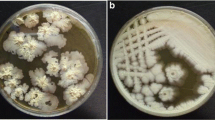Abstract
We have investigated the production of proteinase and phospholipase by 20 different isolates of Paracoccidioides brasiliensis. Isolates were grown in Bacto-peptone, Dextrose, pH 5.5, agar slants, at 27 °C for 30 days, and cultures were transferred onto Petri dishes containing basis medium and bovine serum albumin fraction V and sterile egg yolk as substrates for enzyme production, and incubated at 27 °C. After 30 days net enzyme activity was visualized and quantitavely evaluated, measuring a ratio between colony diameter and diameter of the transparent (proteinase) or white (phospholipase) ring zone surrounding it. Results demonstrated that all isolates had the ability to produce proteinase and phospholipase, even though variability in enzyme production was noted among different isolates of P. brasiliensis.
Similar content being viewed by others
References
Artagaveytia-Allende RC and Montemayor L. Estudio comparativo de varias cepas de Paracoccidioides brasiliensis y especies afines. Mycopathologia 1947–1949; 356–366.
Bedoya-Escobar VI, Naranjo-Mesa MS, Restrepo-Moreno A. Detection of proteolytic enzymes released by the dimorphic fungus P. brasiliensis. J Med Vet Mycol 1993; 31: 304.
Kothary MH, Chase T Jr, Macmillan JD. Correlation of elastase production by some strains of A. fumigatus with ability to cause invasive aspergillosis in mice. Infect Immun 1984; 43: 320–325.
Kwon-Chung KJ, Bennett JE. Medical Mycology. Philadelphia: Lea & Febiger, 1992: 610, 866.
Mendes-Gianini MJS, Moraes RA Ricci TA. Proteolytic activity of the 43.000 molecular weight antigen secreted by P. brasiliensis. Rev Inst Med Trop Sao Paulo 1990, 32: 384–385.
Minocha Y, Pasricha JS, Mohapatra LN, Kandhari KC. Proteolytic activity of dermatophytes and its role in the pathogenesis of skin lesions. Sabouraudia 1971; 10: 79–85.
Odds FC. Presidential address. C. albicans, the life and times of a pathogenic yeast. J Med Vet Mycol 1994; 32: 1–8.
Vaz CAC, Mackenzie DWR, Hearn V, Camargo ZP, Singer-Vermes LM, Burger E, Calich VLG. Gelatinase activity of exoantigens from virulente and non-virulerite isolates of P. brasiliensis. Med Vet Mycol 1994; 33: 27–31.
Gardini-Tuesta WE. Relaciones biologicas entre Paracoccidioides, Biastomyces e Histoplasma. An Fac Med Lima 1996; 49: 82–108.
Gilardi GL., Laffer NC. Nutritional studies on the yeast phase of Biastomyces dermatidis and B. brasiliensis. J Bacteriol 1962, 83: 219–227.
Lacaz C da S. Novos dados em relação à blastomicose sulamericana e seu agente etiológico. Rev Med Cir São Paulo 1949; 9: 303–340.
Minami PS Contribuição para o estudo da atividade bioquímica do P. brasiliensis [Thesis]. São Paulo,Brasil: Faculdade de Medicina, University of São Paulo, 1968; 51 pp.
Odds FC, Abbot AB. A simple system for the presumptive identification of C. albicans and differentiation of stains within the species. Sabouraudia 1980; 18: 301–317.
Souza BEM, Paula CR, Gambale W., Corr_ea B, Cury AF. Aspectos morfo-fisiológicos, fatores de virul_encia e sensibilidade a antifÚngicos de amostras de Candida albicans, sorotipo A e B, isoladas em Sao Paulo, Brasil. Rev Microbiol 1990; 21: 247–253.
Nogueira DM. Alguns aspectos fisiológicos do P. brasiliensis. An Farm Quim Sao Paulo 1959; 10: 7-8.
Yarzabal LA, Andrieu S, Bout D, Naquira F. Isolation of a specific antigen with alkalin phosphatase activity from soluble extracts of Paracoccidioides brasiliensis. Sabouraudia 1976; 14: 257–280.
Yarzábal LA, Biguet J, Vaucelle T, Andrieu S, Torres JM, Da Luz S. Analisis Imunoquimico de extractos solubles de Paracoccidioides brasiliensis. Sabouraudia 1973; 11: 80–88.
Assis CM, Mendes-Gianini MJS, Gambale W. Isolation and morphology of an immunoreactive outer cell wall proteins produce by P. brasiliensis-113. In: Pan American Association of Biochemical Societies 6, and Sociedade Brasileira de Bioquímica e Biologia Molecular 19, São Paulo, Feb., 1990. Abstract and program 1990: 163.
Carmona AK. Puccia R, Oliveira MCF, Rodrigues EG, Juliano L, Travassos LR. Characterization of an exocellular serinethiol proteinase activity in P. brasiliensis. Biochem J 1995; 309: 209–214.
Ferreira MS, Freitas LH, Lacaz C da S, Del Negro OMB, Melo NT, Garcia NM, Assis CM, Salebian A, Heins-Vaccari EM. Isolation and characterization of a P. brasiliensis strain from a dogfood probably contaminated with soil in Uberlandia, Brazil. J Med Vet Mycol 1990; 28: 253–256.
Garcia NM, Del Negro OMB, Heins-Vaccari EM, Melo NT, Assis CM, Lacaz C da S. Paracoccidioides brasiliensis, nova amostra isolada de fezes de um pinguim (Pygocelis adeliae). Rev Inst Med Trop São Paulo 1993; 35: 227–235.
Vidal MSM, Melo NT De, Garcia NM, Del Negro GMB, Assis CM, Heins-Vaccari EM, Naiff RD, Mendes RP, Lacaz C. S. Paracoccidioides brasiliensis: A myco logic and immunochemical study of a sample isolated from an armadillo (Dasipus novencinctus). Rev Inst Med Trop São Paulo 1995; 37: 43–49.
Ruchell R, Tegeler R, Trost M. A comparison of secretory proteinases from different strains of Candida albicans. Sabouraudia 1982; 20; 233–244.
Price MF Wilkinson ID, Gentry LO. Plate method for detection of phospholipase in Candida albicans. Sabouraudia 1982; 20: 7–14.
Macfarlane MB, Knight BCJG. The biochemistry of bacterial toxins. I the lecithinase activity of Clostridium welchii toxins. Biochem J 1941; 35: 884–902.
Heise N, Cardoso de Almeida ML. Detection of glycosylphosphatidylinositol anchored proteins and phospholipase C in P. brasiliensis. In: Maresca, B. and Kobayashi, G.S, eds. Molecular Biology of Pathogenic Fungi. New York: Telos Press, 1994: 499–506.
Author information
Authors and Affiliations
Rights and permissions
About this article
Cite this article
de Assis, C.M., Gambale, W. & Paula, C.R. Production of proteinase and phospholipase by Paracoccidioides brasiliensis . Mycopathologia 146, 13–17 (1999). https://doi.org/10.1023/A:1007022110989
Issue Date:
DOI: https://doi.org/10.1023/A:1007022110989




